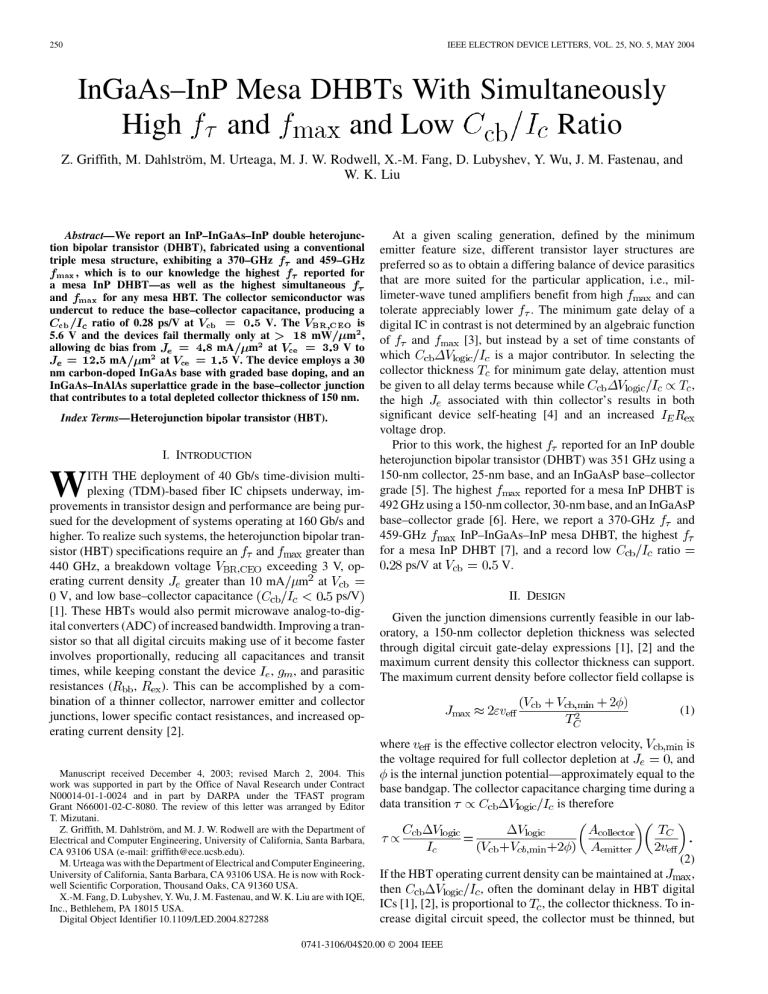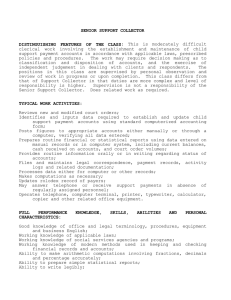InGaAs–InP Mesa DHBTs With Simultaneously High f and fmax and
advertisement

250 IEEE ELECTRON DEVICE LETTERS, VOL. 25, NO. 5, MAY 2004 InGaAs–InP Mesa DHBTs With Simultaneously High f and fmax and Low Ccb=Ic Ratio Z. Griffith, M. Dahlström, M. Urteaga, M. J. W. Rodwell, X.-M. Fang, D. Lubyshev, Y. Wu, J. M. Fastenau, and W. K. Liu Abstract—We report an InP–InGaAs–InP double heterojunction bipolar transistor (DHBT), fabricated using a conventional and 459–GHz triple mesa structure, exhibiting a 370–GHz reported for max , which is to our knowledge the highest a mesa InP DHBT—as well as the highest simultaneous and max for any mesa HBT. The collector semiconductor was undercut to reduce the base–collector capacitance, producing a ratio of 0.28 ps/V at cb = 0 5 V. The BR CEO is cb 18 mW m2 , 5.6 V and the devices fail thermally only at 2 allowing dc bias from = 4 8 mA m at ce = 3 9 V to = 12 5 mA m2 at ce = 1 5 V. The device employs a 30 nm carbon-doped InGaAs base with graded base doping, and an InGaAs–InAlAs superlattice grade in the base–collector junction that contributes to a total depleted collector thickness of 150 nm. Index Terms—Heterojunction bipolar transistor (HBT). I. INTRODUCTION W ITH THE deployment of 40 Gb/s time-division multiplexing (TDM)-based fiber IC chipsets underway, improvements in transistor design and performance are being pursued for the development of systems operating at 160 Gb/s and higher. To realize such systems, the heterojunction bipolar trangreater than sistor (HBT) specifications require an and exceeding 3 V, op440 GHz, a breakdown voltage erating current density greater than 10 mA m at V, and low base–collector capacitance ps/V [1]. These HBTs would also permit microwave analog-to-digital converters (ADC) of increased bandwidth. Improving a transistor so that all digital circuits making use of it become faster involves proportionally, reducing all capacitances and transit , and parasitic times, while keeping constant the device , , ). This can be accomplished by a comresistances ( bination of a thinner collector, narrower emitter and collector junctions, lower specific contact resistances, and increased operating current density [2]. Manuscript received December 4, 2003; revised March 2, 2004. This work was supported in part by the Office of Naval Research under Contract N00014-01-1-0024 and in part by DARPA under the TFAST program Grant N66001-02-C-8080. The review of this letter was arranged by Editor T. Mizutani. Z. Griffith, M. Dahlström, and M. J. W. Rodwell are with the Department of Electrical and Computer Engineering, University of California, Santa Barbara, CA 93106 USA (e-mail: griffith@ece.ucsb.edu). M. Urteaga was with the Department of Electrical and Computer Engineering, University of California, Santa Barbara, CA 93106 USA. He is now with Rockwell Scientific Corporation, Thousand Oaks, CA 91360 USA. X.-M. Fang, D. Lubyshev, Y. Wu, J. M. Fastenau, and W. K. Liu are with IQE, Inc., Bethlehem, PA 18015 USA. Digital Object Identifier 10.1109/LED.2004.827288 At a given scaling generation, defined by the minimum emitter feature size, different transistor layer structures are preferred so as to obtain a differing balance of device parasitics that are more suited for the particular application, i.e., miland can limeter-wave tuned amplifiers benefit from high tolerate appreciably lower . The minimum gate delay of a digital IC in contrast is not determined by an algebraic function and [3], but instead by a set of time constants of of is a major contributor. In selecting the which for minimum gate delay, attention must collector thickness be given to all delay terms because while , associated with thin collector’s results in both the high significant device self-heating [4] and an increased voltage drop. Prior to this work, the highest reported for an InP double heterojunction bipolar transistor (DHBT) was 351 GHz using a 150-nm collector, 25-nm base, and an InGaAsP base–collector reported for a mesa InP DHBT is grade [5]. The highest 492 GHz using a 150-nm collector, 30-nm base, and an InGaAsP and base–collector grade [6]. Here, we report a 370-GHz InP–InGaAs–InP mesa DHBT, the highest 459-GHz for a mesa InP DHBT [7], and a record low ratio ps/V at V. II. DESIGN Given the junction dimensions currently feasible in our laboratory, a 150-nm collector depletion thickness was selected through digital circuit gate-delay expressions [1], [2] and the maximum current density this collector thickness can support. The maximum current density before collector field collapse is (1) where is the effective collector electron velocity, is the voltage required for full collector depletion at , and is the internal junction potential—approximately equal to the base bandgap. The collector capacitance charging time during a is therefore data transition (2) If the HBT operating current density can be maintained at , , often the dominant delay in HBT digital then ICs [1], [2], is proportional to , the collector thickness. To increase digital circuit speed, the collector must be thinned, but 0741-3106/04$20.00 © 2004 IEEE GRIFFITH et al.: InGaAs–InP MESA DHBTs WITH SIMULTANEOUSLY HIGH AND 251 Fig. 2. Measured microwave gains. Fig. 1. Common emitter I–V characteristics. not to the point the HBTs cannot operate at due to either excessive device self-heating [3] or excessive voltage drop on the emitter parasitic resistance. As is reduced and consequently increased, progressive reductions in thermal and emitter parasitic resistance are therefore resistance required, in addition to narrowing the emitter junction for reper unit emitter area. duced Low base resistance is desirable for both low gate delay . The InGaAs base is heavily doped for low base and high contact resistance, and a combination of a doping grade and thin 30-nm base both increase dc current gain and decrease base transit time. Details of the base and collector layer design are given in [8]. Contacts to the subcollector are on 12.5 nm of n InGaAs above the n InP. The InGaAs portion of the subcollector acts as an etch stop layer and is needed to maintain low . Recognizing that the thermal conductivity of bulk InGaAs K ) is much lower than InP (0.68 K ), (0.048 the InGaAs subcollector is kept thin to minimize thermal resistance to the substrate to enable high device operating current [4]. density III. GROWTH AND FABRICATION The epitaxial material was grown by IQE Inc. on a 3-in SI-InP wafer and the HBTs were fabricated in an all-wet-etch, triple-mesa process. Emitter contact widths vary from 0.4–2.0 m and self-aligned base contacts extend 0.3, 0.5, or 1 m on each side of the emitter metal. To reduce the external base–collector capacitance of the device underneath the base contact, the active collector semiconductor was over etched during formation of the base–collector junction producing 200 nm of undercut. After device passivation with polyimide, a single layer of metal forms device interconnects. IV. RESULTS Standard transmission line measurement (TLM) show the base and m , collector and m , and the emitter m . The HBTs have a dc current gain of 8–11 and the breakdown is 5.6 V. Fig. 1 shows common emitter voltage current–voltage (I–V) characteristics. Fig. 3. C =A , the collector–base capacitance normalized to the emitter junction area as a function of bias. and device junction temperature Thermal resistance were measured using the method of Liu [9]. An HBT with a K emitter 0.6- m emitter junction width exhibits a junction-to-ambient temperature increase when dissipating 18 mW m , mW m . The devices fail thermally only at mA m at V to allowing dc bias from mA m at V. Note that the collector junction may be substantially hotter than the emitter junction due to the combined effects of heat removal from the emitter through the emitter interconnect metal, and the high thermal resistance of the InGaAs base layer. Our 5–30- and 75–110-GHz RF measurements were performed using on-wafer line-reflect-line (LRL) calibration structures, as well as open-short-line-thru (OSLT) calibration in the 5–30 GHz band. Because different on-wafer pad structures are required, the 5–30- and 75–110-GHz data is taken from different devices having the same dimensions. The HBTs exhiband 459-GHz ited a simultaneous maximum 370-GHz (Fig. 2) at mA and V( mA m , V). The devices have a m emitter junction and 1.7- m base-mesa width. At these dc bias conditions and HBT dimensions, the devices experience an emitter to ambient K. In addition, comparisons temperature increase of for the measured dc common-emitter of I–V characteristics (Fig. 1) and the low-frequency RF values (Fig. 2) are in good agreement with each other, 26 dB. Fig. 3 252 IEEE ELECTRON DEVICE LETTERS, VOL. 25, NO. 5, MAY 2004 shows the variation of versus operating current density and for use in emitter coupled logic (ECL) circuit V, design. For HBTs biased as ECL emitter followers ( mA m ), the minimum before Kirk effect is V, 0.75 ps/V while for ECL current steering HBTs ( mA m ), ps/V. The improvements in HBT performance compared to [8] are due to decreased base and emitter contact resistances, increased current density, and a collector undercut of 200 nm. The measured HBT performance is consistent with an HBT finite element model [2] using the measured contact and sheet resistivities, the known device geometry, and values of base electron diffusivity and collector electron velocity extracted from a set of measurements on similar DHBTs on the wafer. [2] M. J. W. Rodwell, M. Urteaga, Y. Betser, D. Scott, M. Dahlström, S. Lee, S. Krishnan, T. Mathew, S. Jaganathan, Y. Wei, D. Mensa, J. Guthrie, R. Pullela, Q. Lee, B. Agarwal, U. Bhattacharya, and S. Long, “Scaling of InGaAs–InAlAs HBTs for high speed mixed-signal and mm-wave ICs,” Int. J. High-Speed Electron. Syst., vol. 11, no. 1, pp. 159–215, 2001. [3] W. Hafez, J.-W. Lai, and M. Feng, “InP–InGaAs SHBTs with 75-nm collector and 500 GHz,” Electron. Lett., vol. 39, no. 20, pp. 1475–1476, 2003. [4] I. Harrison, M. Dahlström, S. Krishnan, Z. Griffith, Y. M. Kim, and M. J. W. Rodwell, “Thermal limitations of InP HBTs in 80 and 160 Gbits ICs,” in Proc. IEEE Int. Conf. Indium Phosphide and Related Materials, Santa Barbara, CA, May 12–16, 2003, pp. 160–163. [5] M. Ida, K.Kenji Kurishima, and N. Watanabe, “Over 300 GHz and InP–InGaAs double heterojunction bipolar transistors with a thin pseudomorphic base,” IEEE Electron Device Lett., vol. 23, pp. 694–696, Dec. 2002. [6] , “High-speed InP–InGaAs DHBTs with a thin pseudomorphic base,” in Proc. IEEE GaAs IC Conf., San Diego, CA, Nov. 9–12, 2003, pp. 211–214. [7] M. Dahlström, Z. Griffith, M. Urteaga, M. J. W. Rodwell, X.-M. Fang, D. Lubyshev, Y. Wu, J. M. Fastenau, and W. K. Liu, “InGaAs–InP DHBTs and using a graded carbon-doped base,” in with 370 GHz Proc. IEEE Device Research Conf., Salt Lake City, UT, June 23–25, 2003. [8] M. Dahlström, X.-M. Fang, D. Lubyshev, M. Urteaga, S. Krishnan, N. Parthasarathy, Y. M. Kim, Y. Wu, J. M. Fastenau, W. K. Liu, and M. J. W. Rodwell, “Wideband DHBTs using a graded carbon-doped InGaAs base,” IEEE Electron Device Lett., vol. 24, pp. 433–435, July 2003. [9] W. Liu, Handbook of III–V Heterojunction Bipolar Transistors. New York: Wiley, 1998. f > f f > REFERENCES [1] T. Enoki, E. Sano, and T. Ishibashi, “Prospects of InP-based IC technologies for 100-Gbit/s-class lightwave communications systems,” Int. J. High-Speed Electron. Syst., vol. 11, no. 1, pp. 137–158, 2001. f f

